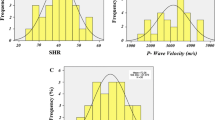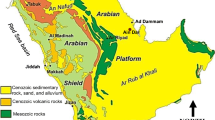Abstract
Preparing high-quality samples, which can fulfill testing standards, from weak and block-in-matrix conglomerate for laboratory tests, is a big challenge in engineering projects. Hence, using indirect methods seems to be indispensable for determination uniaxial compressive strength (UCS). The main objective of this study is to estimate the relation between sonic velocity (Vp), Schmidt hammer rebound number (SCH) and UCS. For this reason, some samples of weak conglomeratic rock were collected from two different sites of dam in Iran (Bakhtiari and Hezardareh Formations). In order to evaluate the correlation, the measured and predicted values utilizing simple and multivariate regression techniques were examined. To control the performance of the proposed equation, root mean square error (RMSE) and value accounts for (VAF%) were determined. The VAF% and RMSE indices were computed as 94.34 and 1.56 for the relation between Vp and UCS from simple regression model. These were 94.39 and 1.6 between SCH and UCS, while these were 97.24 and 1.34 for uniaxial compressive strengths obtained from multivariate regression model.





Similar content being viewed by others
References
Abdollatif O (2010) Geomechanical properties and rock mass quality at the carbonate Rus formation, dammam dame, Saudi Arabia. The Arabian J Sci Eng 35
Akram M, Bakar ZA (2007) Correlation between uniaxial compressive strength and point load index for salt-range rocks. Pak J Eng & Appl Sci 1
Aydin A, Basu A (2005) The Schmidt hammer in rock material characterization. Eng Geol 81:1–14
Bernabé Y, Fryer TD, Hayes JA (1992) The effect of cement on the strength of granular rocks. Geophys Res Lett 19(14):1511–1514
Cobanglu I, Celik S (2008) Estimation of uniaxial compressive strength from point load strength, Schmidt hardness and P-wave velocity. Bull Eng Geol Environ 67:491–498
Dehghan S, Sattari GH, Chehre Chelgani S, Aliabadi MA (2010) Prediction of uniaxial compressive and modulus of elasticity for travertine sample using regression and artificial neural networks. Mining Sci Technol 20:41–46
Diamantis K, Gartzos E, Migiros G (2009) Study on uniaxial compressive strength, point load strength index, dynamic and physical properties of serpentinites from Central Greece: test results and empirical relations. Eng Geol 108:199–207
Entwisle DC, Hobbs PRN, Jones LD, Gunn D, Raines MG (2005) The relationship between effective porosity, uniaxial compressive strength and sonic velocity of intact Borrowdale Volcanic Group core samples from Sellafield. Geotech Geol Eng 23:793–809
Gupta V (2009) Non-destructive testing of some Higher Himalayan rocks in the Satluj Valley. Bull Eng Geol Environ 68:409–416
Haramy KY, DeMarco MJ (1985) Use of Schmidt hammer for rock and coal testing. 26th US Symp on Rock Mech, Rapid City, 549–555
ISRM (1981) Rock characterization, testing and monitoring, ISRM suggested methods. Pergamon, Oxford, 211
Kahraman S (2001) Evaluation of simple methods for assessing the uniaxial compressive strength of rock. Int J Rock Mech Mining Sci 38:981–994
Katz O, Reches Z, Roegiers JC (2000) Evaluation of mechanical rock properties using a Schmidt hammer. Int J Rock Mech Mining Sci 37(4):723–728
Khandelwal M, Singh TN (2009) Correlating static properties of coal measures rocks with p-wave velocity. Int J Coal Geol 79:55–60
Kurtulus G, Irmak T, Sertcelik I (2010) Physical and mechanical properties of Gokcseda: Imbros (NE Aegean Sea) Island andesites. Bull Eng Geol Environ 69:321–324
Mccann DM, Culshaw MG, Northmore KJ (1990) Rock mass assessment from seismic measurements. Culshaw B, Coffey C (eds) Fields testing in engineering geology. Geol Soc Eng Pub No 6:257–266
Moradian ZA, Behnia M (2009) Predicting the uniaxial compressive strength and static Young’s modulus of intact sedimentary rocks using the ultrasonic test. Int J Geomech 9:1–14
Shalabi F, Cording EJ, Al-Hattamleh OH (2007) Estimation of rock engineering properties using hardness tests. Eng Geol 90:138–147
Sharma PK, Singh TN (2008) A correlation between P-wave velocity, impact strength index, slake durability index and uniaxial compressive strength. Bull Eng Geol Environ 67:17–22
Singh RN, Hassani, FP, Elkington PAS (1983) The application of strength and deformation index testing to the stability assessment of coal measures excavations. Proc 24th US Symp on Rock Mechs, Texas A&M Univ AEG, 599–609
Yagiz S (2009) Predicting uniaxial compressive strength, modulus of elasticity and index properties of rocks using the Schmidt hammer. Bull Eng Geol Environ 68:55–63
Yagiz S (2011) Geomechanical properties of construction stones quarried in South-western Turkey. Bull Mater Sci 34:947–953
Yasar E, Erdogan Y (2004a) Correlating sound velocity with the density, compressive strength and Young’s modulus of carbonate rocks. Int J Rock Mech Mining Sci 41:871–875
Yasar E, Erdogan Y (2004b) Estimation of rock physicomechanical properties using hardness methods. Eng Geol 71:281–288
Yilmaz I, Sendir H (2002) Correlation of Schmidt hardness with unconfined compressive. Eng Geol 66:211–219
Yilmaz I, Yuksek AG (2007) An example of artificial neural network application for indirect estimation of rock parameters. Int J Rock Mech Mining Sci 5(41):781–795
Yin H, Dvorkin J (1994) Strength of cemented grains. Geophys Res Lett 21(10):903–906
Author information
Authors and Affiliations
Corresponding author
Rights and permissions
About this article
Cite this article
Minaeian, B., Ahangari, K. Estimation of uniaxial compressive strength based on P-wave and Schmidt hammer rebound using statistical method. Arab J Geosci 6, 1925–1931 (2013). https://doi.org/10.1007/s12517-011-0460-y
Received:
Accepted:
Published:
Issue Date:
DOI: https://doi.org/10.1007/s12517-011-0460-y




